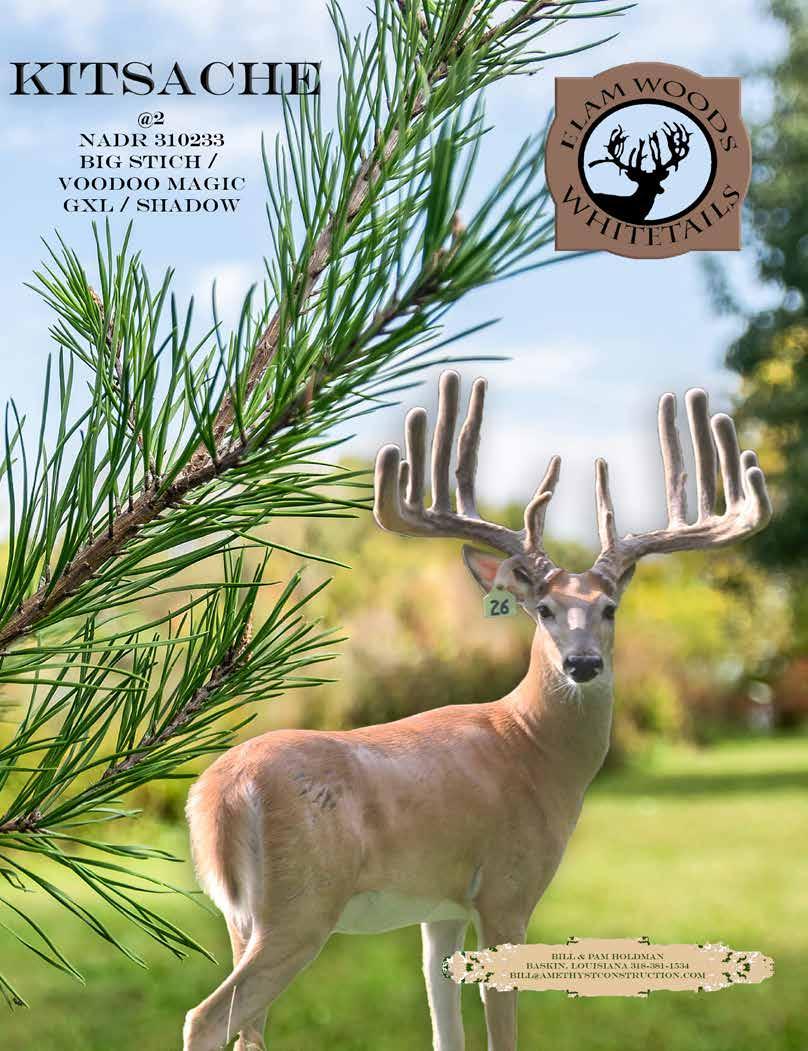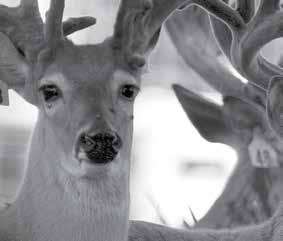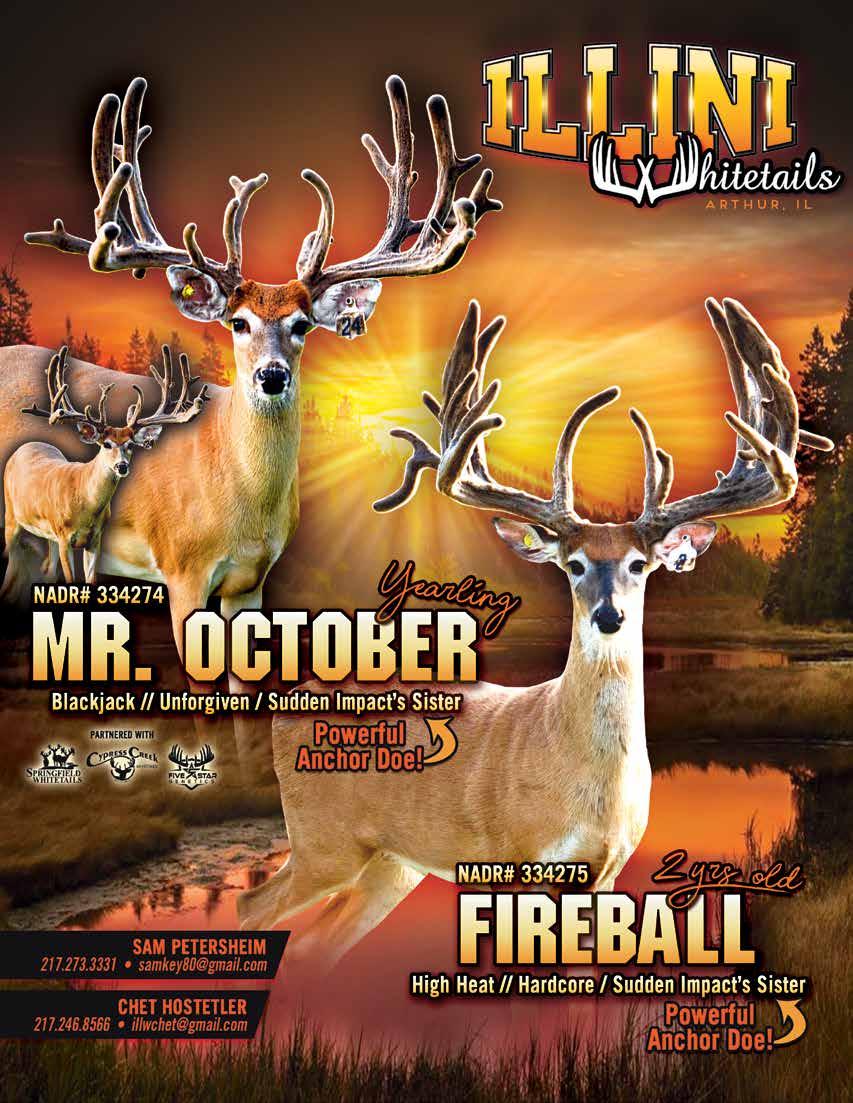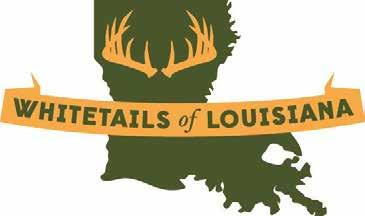












President 56099 Dohm Road Loranger, LA 70446 985-264-3437
bbollinger@gulfcraneservices.com
242 Daniel Thomas Road Springhill, LA 71075 318-469-9404 dbthomas40@gmail.com

404 Atkins Place Benton, LA 71006 318-470-6666 chad.jeane@strikeusa.com
LLOYD GOUGH 1655 Beechcreek Road Olla, LA 71480 318-277-6245







lloydg277@icloud.com
38334 Shelby Drive Denham Springs, LA 70706 225-445-4459
bjclark.ds20@gmail.com

Administrator: Whitetails Of Louisiana P.O. Box 436, Folsom, LA 70437 985-892-0056 whitetailsoflouisiana@gmail.com







Secretary / Treasurer 146 Coteau Dugypre Lane Gheens, LA 70355 985-227-3664 josh@goldenranch.com
56099 Dohm Road Loranger, LA 70446 985-400-1667 bray@gulfcraneservices.com
KRISTINA ROTHSCHILD 3220 Tisdale Road Eros, LA 71238 318-355-4197 krisrothschild@yahoo.com
















































































Thesite of blood on a buck’s antler should mean one thing to any deer farmer. Drop everything and treat it. Whether treatment involves cutting the antlers or administering first aid in the form of antibiotics or topical ointments “don’t push it off until the next day,” said Joe Miller of Kentucky Whitetails, a 17-acre deer farm home to approximately 90 whitetails in Guthrie, Kentucky. “You can’t say ‘I will do it tomorrow.’ The possibility of serious problems or losing that buck to a blood infection is real.”
Although not formally recognized as a predator in the traditional sense, flies can cause blood infections should they lay eggs in an untreated infected antler and maggots result. “If you can control the flies, you have a better chance of avoiding this,” offers Nathan Blosser of Blosser Whitetails, a 50-acre farm with close to 400 whitetail deer in Buffalo, Missouri. Miller and Blosser agree that feeding topical ivermectin on deer feed can be a good defense against maggots as well as a worthwhile proactive health measure.
While injuries such as those caused from feeders or fencing can cause antler damage, shedding season also poses risks if antlers aren’t shed within a day, advised Miller, and recommends all deer farmers own a Callicrate Velvet Antler Bander to safely cut antlers and minimize bleeding for such occasions. “The bigger the antlers, the harder time they have shedding them,” said Miller, 65, a deer farmer since 1999. “If they aren’t shed in a day, flies can get in there and poison them. If so, we dart them when it’s cool, cut the antlers and clean them from the base and leave about three inches. Then we give a heavy dose of ivermectin and a shot of the long-lasting antibiotic Draxxin and sometimes a regular dose of penicillin
on top of it. We also put caustic powder on the ends to help it heal faster. Some farmers like to burn the tips. We’ve never done that.”
Congruently, Blosser, 56, has found in addition to using antibiotics, that Melaluca oil is excellent at deterring flies while penetrating into and cleaning antlers. He also uses Aluma Shield (used traditionally on wounds in horse hooves) that creates an aerosol bandage to protect from outside elements. Although both Blosser and Miller only see infected antlers less than a handful of times each year on their prospective farms, each had more cases earlier on in their deer farming careers. As a result, Miller, who prefers to raise typicals with a “little extra,” constructed a better feeder with 6 x 6 posts placed ten feet apart accompanied by eight or 10-inch PVC pipe after seeing the antler damage the original one had caused. “Now, if they jerk their head up, they won’t hit anything. Most of the time It’s the drop tines or more non-typical frames that can give you the biggest problems with catching or hitting things,” he added.
Drop tines, combined with reaching under fencing to get to grass can be another major cause of antler damage,
Blosser uses this type of feeder on his deer farm


Blosser found, who also prefers to raise typicals with a “little extra.” “So don’t leave your deer in bare pens,” he said. “This type of prevention is the key to avoiding antler damage along with regularly observing your animals. If caught early enough, an antler infection can show improvement in one day. If not and the infection has become septic, it may take a buck as long as two weeks to be back to normal. Taking action early along with fly control is important in keeping your herd healthy.”
Lastly, no matter how bad you believe an antler infection is “you’ve always got to try and save them,” Miller said. “With all the time and effort put into raising them, it’s always worth trying.”


 By: Gail Veley
By: Gail Veley
RedRidge Whitetails is more to Operations Manager Josh Newton than just a place to raise and sell deer. At the end of the day, the farm is a representation of all that is good about the deer industry. From the development, breeding and raising of quality seed stock for hunting ranches, to the practice of superior animal husbandry to the promotion of private land management and conservation, Newton’s goal is to help the industry as a whole to thrive and prosper. And he wants the governing bodies in his state, as well as in other states, to know how diligently deer farmers work to improve the health and vitality of whitetails in many facets including the potential eradication of CWD.
Yet, there are moments when Newton relaxes, however brief and cherished those moments might be on the peaceful and lush 10-acre farm in Williamsport, Pennsylvania. Then, he just simply enjoys his deer and his role as a father to his young daughters

Lena, 5, and Gianna, 2. Watching them interact with fawns alongside his wife Lisa, 37, reminds him of how it all started. For this, Newton is grateful for the other lessons offered through deer farming. “The real lesson is the life itself,” Newton, 41, shared. “And whether we like it or not the reality is that life does exist and (the deer) depend on you. Sadly, some do die. But these experiences create a normal traditional value mindset and animals are a great conduit for that.”
Creating the desire to raise deer started in 1999 when Josh was 17 and visited his uncle’s deer farm for the first time. Within moments of being there, what stirred in his soul was something he couldn’t ignore. He bought his first deer and never looked back. Through working on the farm and learning a vast majority of relevant management skills, he eventually became the operations manager of Red Ridge Whitetails in 2006 after a fateful encounter and subsequent three-hour conversation with the owner. Today, Newton might be considered a walking encyclopedia or a beacon of information on whatever subject pertaining to whitetails you want to discuss. His never-ending drive to represent the industry and continually learn also extends to his role as President of the Pennsylvania Deer Farmer’s Association.
His education didn’t always come easily or happen overnight. It evolved after Newton’s worst and ultimately best experience at Red Ridge Whitetails. After the heartbreak and exasperation of watching close to 20 fawns die within
three weeks in 2008, Newton vowed “never again.” Through his grief and resolve, Cervid Solutions, a company dedicated to providing cervid specific vaccines as well as health management protocols, was founded and today ensures that all deer at Red Ridge (and other farms) live the healthiest lives possible. By using Cervid Solutions as the foundation for putting prevention through herd health at the forefront of the farm’s daily operations, and limiting the number of deer per acre, Red Ridge stays poised to continue setting a good example to others.
They are proud to raise typical deer from the likes of Roman, Rango, Legion, Big Fuzz, Two Big and Artisan among several more. Providing preserves and ranches with big-bodied, hearty, classic, genetically viable typical stocker bucks remains a steadfast goal. Their herd, numbering close to 50, are all DNA certified and registered and also GEBV tested for CWD susceptibility.
“The whitetail industry for me always has been, and will continue to be, my labor of love,” Newton said. “Through Cervid Solutions, I can always provide the best health tools for Red Ridge Whitetails and for a multitude of other like-minded deer farmers.”


















































For hunting preserve owners as well as deer farmers (both large and small) would be wise to have the following four insurance policies firmly in place: A Commercial General Liability Policy, an additional Umbrella Policy, a Commercial Auto Policy and Workmen’s Compensation Insurance, according to Insurance Agent Leah Bright of Leavitt Recreation and Hospitality Insurance in Cody, Wyoming.
“It’s like rolling the dice not having the right insurance, or any insurance,” Bright said. Businesses shouldn’t make decisions on whether or not to buy insurance based on the potential probability of liability, or on the size of their operation. “I don’t think it’s a matter of is your business too small or too low in liability risk to need insurance,” she emphasized. “If a child wanders into a deer pen and gets killed – how much is that child worth? Having adequate insurance coverage offers the peace of mind that you can continue to operate your farm.”
Many small deer farmers are under the mistaken impression that their HO-3 Homeowners Policy also extends to their deer business, said Dave Vanderzee, President of The New York Deer and Elk Farmers Association. While a typical homeowner’s policy covers perils such as theft, wind, hail, lightening strikes, floods, fire and structural damage to your dwelling or outbuildings, “when you engage for profit there is a different set of laws,” he said. “If you have any outside business activity such as raising cervids or maybe a commercial garden you are dangerously out-skirting your policy. In the event of a liability situation most homeowner’s policy will cancel you and may not recognize or defend you.”
Obtaining a Commercial General Liability Policy can offer the protection needed for most situations that arise from operating your deer business, Bright said. For example, should someone fall in a hole at a hunting preserve and break
their leg or should a tree branch fall on a customer’s vehicle and smash a window, a Commercial General Liability Policy can offer protection and payouts up to the amount agreed upon when the policy is started. That same policy can continue to offer protection and payouts up to the annual maximum or aggregate amount (such as $2 million per year.) However, should your business prove riskier to operate than others, an additional Umbrella Policy can offer protection in the event of your Commercial General Liability Policy reaching its annual aggregate limit.
Another vital form of insurance involves Commercial Auto insurance, designed for anyone who uses their personal vehicles to operate their business, such as giving farm tours or transporting hunters, Bright said. Should a vehicle accident or injury occur to a customer visiting your premises, a Commercial Auto Policy will cover medical payments, unlike a personal auto policy which would not. “We would highly recommend Commercial Auto Policy because most personal auto policies have a business use exclusion and if passengers are exiting or entering a vehicle or you hit a hole and someone strikes their head on the ceiling or other injuries occur, you are responsible,” Bright said. “Not having this type of insurance can present a liability bridge back to your personal assets. You don’t want that.”
As an added layer of legally required and necessary protection for payrolls over $20,000 annually, Workmen’s Compensation Insurance offers wage replacement and medical benefits to employees injured in the course of employment in exchange for mandatory relinquishment of the employee’s right to sue the employer for negligence. “Again, this gives you the peace of mind that you can continue to operate your farm,” Bright added. “This is also needed for 1099 employees.”

Perhaps as valuable as the right insurance are the steps you can take to limit the probability of a lawsuit occurring. This can include posting warning signs, using liability waivers, utilizing lift ropes and other tree stand safety equipment such as harnesses and conducting marksmanship orientation classes on gun handling safety. It can also include contractual agreements with those parties whose land may be used by hunting preserves, so as to give the ability to include the landowner as an “additional insured” on a Commercial General Liability policy. (Interestingly enough, playing golf is statistically more dangerous than hunting at a preserve, Bright noted. Golfers get crushed by golf carts more often than hunters fall out of tree stands or get shot.)
Currently there are no known policies that cover the loss or replacement of whitetail deer or exotics, as these species are not considered domestic, and the cost to implement such a policy would be prohibitive, said Insurance Agent John Long Jr. of United Insurance Agency Incorporated in Amherst, New York.
As you strive to protect your deer, your assets and to operate as proficiently as possible, Vanderzee highly recommends having an “eyeball-to-eyeball” meeting with an insurance professional to ascertain what the risks are to you and your family and your employees and to help find you the most economical way to get all the coverages you need. He also stresses the importance of your policies outliving any statutes of limitations.
“People kind of dislike insurance,” Vanderzee said. “Beware of polices where the big print gives it to you and the small print takes it away. The time to find out isn’t when you have a claim. Read your policies and be your own advocate.”







 By: Gail Veley • Sponsored by The North Dakota Deer Ranchers Association
By: Gail Veley • Sponsored by The North Dakota Deer Ranchers Association

Mikeand Kristy Ryckman aren’t too concerned about giving away one of the best kept secrets of North Dakota: It’s a superb state for deer farming. “I feel safe to say we could double the amount of deer farmers we have here currently, and still would not meet all the demand we have,” Mike Ryckman, 38, owner of Ryckman Whitetails in Linton (south central North Dakota) said. Now in their seventh year of deer farming “we are at the beginning of an uptick in the market,” he explained. “We have new people who are interested and are seeking to act upon it. Quality conversations have been started.”
“The interest I have seen from potential new deer farmers is almost alarming,” he added. “At least five new farms have been started in the last year. And, I get a lot of people who drive by who see our farm, stop to talk and have a lot interest in getting involved.” North Dakota offers supportive legislation with the powers that be: The North Dakota Game and Fish Department as well as The North Dakota Department of Agriculture and Animal Health. Both entities require inspection of properties of would-be deer farmers, however, The Dept. of AG requires and issues a yearly, renewable nontraditional livestock license for $15 per species, said Dr. Beth Carlson, DVM. A secondary permit to possess, propagate or domesticate protected wildlife (PPD
Permit) is required by ND Game and Fish. There is no fee for the PPD Permit and all necessary paperwork is handled through The Dept. of AG. Additional requirements include constructing an eight feet tall game fence for deer pens and an on-site handling facility, as well as the stipulation that a fawning pen not exceed 160 acres.
Deer farmers in North Dakota not only appreciate deer farmer-friendly legislation, they also appreciate the colder weather that helps grow bigger bodied and heartier deer. According to internet research, winter days in North Dakota average 24 degrees, spring days average 52 degrees, summer days average 80 degrees while fall days average 66 degrees. Along with those temperatures comes humidity and frequent wind, making those who help care for their deer as hearty as the livestock they feel so passionate about.
Acquiring deer for your farm can be easier if you buy them from within the state’s borders, advised Bob Miller of Evolution Whitetails in Bismarck, (central) North Dakota. Moving deer inside of North Dakota as well as outside state borders is a relatively easy process. Moving them into North Dakota is slightly harder. However, that didn’t stop Miller, 50, from starting his farm in 2017 and high fencing 15 acres for his prized herd. Having been born and raised in North Dakota, Miller and

his wife Shelly don’t mind a few colder days throughout the year in exchange for the opportunities they have to own a substantial amount of land shared by the family horses, as well as their beloved deer farm.

Although North Dakota “opens the door” to make starting a deer farm a reality, both Ryckman and Miller hold full time professional jobs elsewhere and fully understand it takes at least three to four years of hard work before your farm might start turning a profit. Having recently bought 44 head of deer from another farmer who needed to sell, Miller may need to wait a bit longer before realizing a true profit. Nonetheless, both Miller and Ryckman wouldn’t trade their deer farm for anything else. “I’m extremely happy with it and look forward to being able to just enjoy life,” said Miller, whose vision includes leaving his current career to be a full-time deer farmer. And while he caters to the stocking end of the industry - like all deer farmers – he would be thrilled to also own a prize breeding buck. “I’d take a ‘Blackjack’ any day,” he said.
Current and future association members should plan on attending the NDRA annual meeting, whose date and location have yet to be determined. Call Ryckman for more details at 701-527-2101.



To
high ethical standards
and marketing
the
and
of
To provide educational opportunities for members of the corporation and other interested people through the sharing of inform ation concerning

To serve as a collective voice in governmental issues that
members of the corporation to operate in a legal,
and the general
as to
and forthright manner with
the
industry.
l













